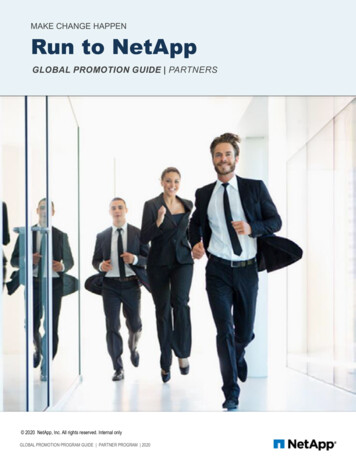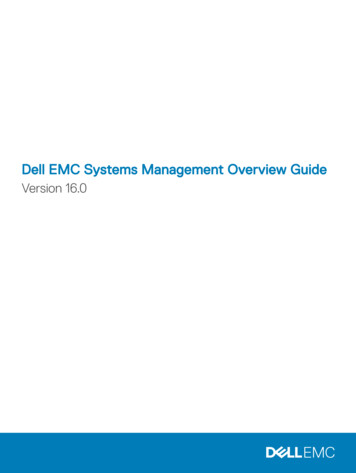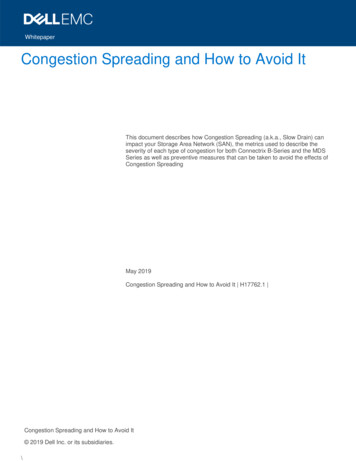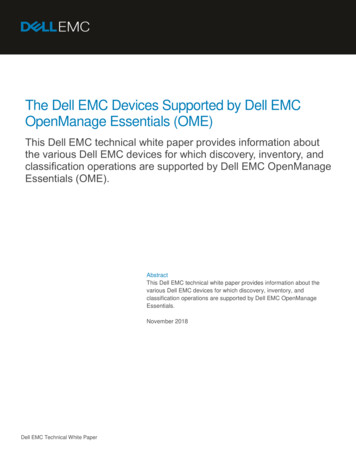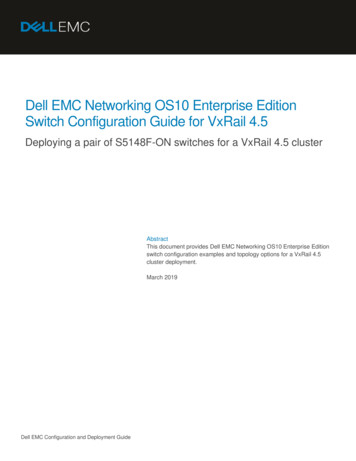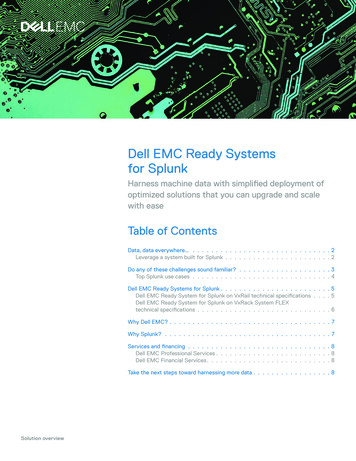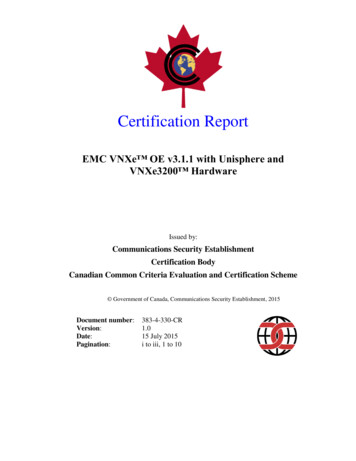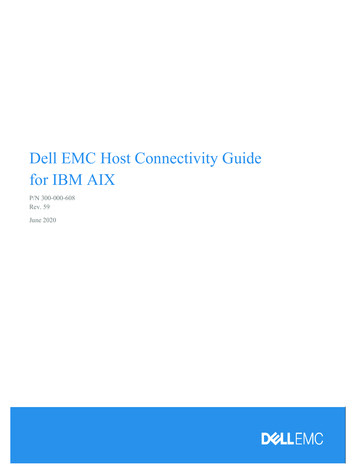
Transcription
Dell EMC Host Connectivity Guidefor IBM AIXP/N 300-000-608Rev. 59June 2020
Copyright 2004 - 2020 Dell Inc. or its subsidiaries. All rights reserved.Dell believes the information in this publication is accurate as of its publication date. The information is subject to change without notice.THE INFORMATION IN THIS PUBLICATION IS PROVIDED “AS-IS.” DELL MAKES NO REPRESENTATIONS OR WARRANTIESOF ANY KIND WITH RESPECT TO THE INFORMATION IN THIS PUBLICATION, AND SPECIFICALLY DISCLAIMS IMPLIEDWARRANTIES OF MERCHANTABILITY OR FITNESS FOR A PARTICULAR PURPOSE. USE, COPYING, AND DISTRIBUTIONOF ANY DELL SOFTWARE DESCRIBED IN THIS PUBLICATION REQUIRES AN APPLICABLE SOFTWARE LICENSE.Dell Technologies, Dell, EMC, Dell EMC and other trademarks are trademarks of Dell Inc. or its subsidiaries. Other trademarks may be theproperty of their respective owners. Published in the USA.Dell EMCHopkinton, Massachusetts 01748-91031-508-435-1000 In North America 1-866-464-7381www.DellEMC.com2Dell EMC Host Connectivity Guide for IBM AIX
CONTENTSContentsPreface. 11Part 1General AIX InformationChapter 1General AIX InformationFeatures of the AIX operating system .Logical volume overview .Useful AIX functions and utilities.Operating system updates.Installation methods.Preparing your system for booting from the Dell EMC storage array .Updating system/service processor-combined microcode .Connecting to the VNX series or CLARiiON system.Installing to the Symmetrix or VNX series or CLARiiON disk .Installing the Dell EMC ODM support package .Special considerations .Adding PowerPath.Potential problems .Failure recovery scenarios.Extended outages.Return the servers to production state .Troubleshooting.Chapter 21820252729313334364042646777798082Virtual I/O ServerVirtual I/O Server overview . 86Virtual I/O Server configuration. 88Virtual I/O Server software installation. 94Virtual I/O Server and client device migration. 99Shared Storage Pools with Virtual I/O Server . 111Logical partition/Virtual I/O Server (LPAR/VIOS) migration. 118Creating a Fibre Channel boot device on the EMC system. 147EMC TimeFinder with Virtual I/O Server. 148Chapter 3Migrating to the Dell EMC Supplied AIX ODM PackageMigration overview .Required software revision levels .Gathering host information.Migration for nonboot on CLARiiON and Symmetrix arrays .Migration when booting from CLARiiON storage arrays .Migration when booting from Symmetrix storage arrays .Migration when booting from XtremIO storage arrays.Migration when migrating client from AIX 6.1 to AIX 7.1 .Chapter 4166167168169171175180185Symantec Veritas Storage Foundation and AIXOverview .VMAX or Symmetrix.VxVM DMP and PowerPath on VNX series or CLARiiON .Symantec Veritas Storage Foundation feature functionality .188189190191Dell EMC Host Connectivity Guide for IBM AIX3
ContentsPart 2Symmetrix ConnectivityChapter 5AIX, VMAX/PowerMax Family EnvironmentAIX, VMAX/PowerMax Family Environment .Making a volume group.Configuring disks using SMIT .Adding devices online .LUN expansion.System and error messages.Chapter 6AIX, VMAX/PowerMax Family over Fibre ChannelAIX, VMAX/PowerMax Family Fibre Channel environment.Host configuration .Addressing VMAX or PowerMax devices.AIX Multiple Path I/O.Fast I/O failure for Fibre Channel devices .Dynamic tracking of Fibre Channel devices .Fast Fail and Dynamic Tracking interaction .VMAX and VMAX3 outputs with the lscfg command.Chapter 7196197199202203204210211215219225226229231AIX and iSCSIGetting started . 234Multipath I/O . 237Clusters . 237Chapter 8Virtual ProvisioningVirtual Provisioning on Symmetrix.Implementation considerations.Operating system characteristics .Thin Reclamation .Part 3Midrange Storage ConnectivityChapter 9IBM AIX Hosts With VNX Series or CLARiiONAIX in a VNX series or CLARiiON environment .Host configuration with IBM native HBAs.Making LUNs available to AIX .LUN expansion.Fast I/O failure for Fibre Channel devices .Dynamic Tracking of Fibre Channel devices .Fast Fail and Dynamic Tracking interaction .Chapter 10240244248249254256260262263264267VNX Series or CLARiiON Nondisruptive Upgrade (NDU)Introduction . 270Non-disruptive upgrades in a VNX series environment with PowerPath . 271Non-disruptive upgrades in a CLARiiON environment with PowerPath . 272Chapter 11AIX with Unity SupportOverview . 2784Dell EMC Host Connectivity Guide for IBM AIX
ContentsPrerequisites .FC connection configuration .iSCSI connection configuration .Booting the host from a Unity disk .Chapter 12AIX with PowerStore SupportOverview .Prerequisites .FC connection configuration .Boot the host from a PowerStore disk.Chapter 13279280282284288289290292Dell EMC SC SeriesPrerequisites . 296PowerPath on Dell EMC SC Series. 297Part 4High AvailabilityChapter 14High Availability With VMAX, Symmetrix, VNX Series, or CLARiiON and AIXOverview .HACMP high availability.PowerHA SystemMirror.AIX LVM mirroring .PowerHA and PowerPath error notification .GPFS clusters .Part 5VirtualizationChapter 15Dell EMC VPLEXVPLEX overview .Prerequisites .Configuring Fibre Channel HBAs with VPLEX.Provisioning and exporting storage .Storage volumes .System volumes.Required storage system setup .Host connectivity.Exporting virtual volumes to hosts.Front-end paths.Configuring IBM AIX to recognize VPLEX volumes .Part 6Data ProtectionChapter 16Data Domain 71374376Overview . 382Prerequisites . 383DFC MPIO Connection Configuration . 384Part 7AppendixDell EMC Host Connectivity Guide for IBM AIX5
Contents6Dell EMC Host Connectivity Guide for IBM AIX
FIGURES123456789101112131415161718192021227Basic logical storage concepts . 21Basic SRDF configuration . 53Virtual SCSI configuration example . 88Virtual Fibre Channel architecture example . 92AIX LPAR initial setup example . 119Virtual I/O Server setup example . 120Final setup example . 121Dual VIOS example . 141The MPIO solution . 219Virtual provisioning on Symmetrix . 240Thin device and thin storage pool containing data devices . 243Stretched cluster example . 314Linked cluster example . 315Nodes using physical I/O server example . 321Nodes using Virtual I/O server example . 322Add a Notify Method dialog box example . 333Four-node GPFS cluster example . 341VPLEX provisioning and exporting storage process . 363Create storage view . 371Register initiators . 372Add ports to storage view . 373Add virtual volumes to storage view . 373
8Dell EMC Host Connectivity Guide for IBM AIX
TABLESTaTables1234567891011121314151617Dell EMC models and minimum operating system requirements . 12JFS2 and JFS functions . 18Logical storage management limits . 23AIX functions and utilities . 25LPAR information . 124Hardware information . 125VIOC information . 136Hardware information . 137VIOS information . 137Symmetrix LUN support . 196Options and parameters for the errpt command . 204Symmetrix SCSI-3 addressing modes . 217Resource group startup, fallover, and fallback policies . 305Values . 331PowerPath error notification objects . 335Required Symmetrix FA bit settings . 368Supported hosts and initiator types . 375Dell EMC Host Connectivity Guide for IBM AIX9
Tableses10Dell EMC Host Connectivity Guide for IBM AIX
PrefacePREFACEAs part of an effort to improve and enhance the performance and capabilities of its productline, Dell EMC from time to time releases revisions of its hardware and software. Therefore,some functions described in this document may not be supported by all revisions of thesoftware or hardware currently in use. For the most up-to-date information on productfeatures, refer to your product release notes.If a product does not function properly or does not function as described in this document,please contact your Dell EMC representative.This guide describes the features and setup procedures for IBM AIX host interfaces to theEMC VNX series and Dell EMC VMAX3, VMAX, Symmetrix, and CLARiiON storagesystems over Fibre Channel and (Symmetrix only) SCSI.IMPORTANTEMC recommends using AIX default settings when connecting AIX hosts to EMC storagearrays unless otherwise mentioned in this guide or other EMC product manuals.AudienceThis guide is intended for use by storage administrators, system programmers, or operatorswho are involved in acquiring, managing, or operating VMAX3, VMAX, Symmetrix, VNXseries, or CLARiiON, and host systems.Readers of this guide are expected to be familiar with:AIX, VMAX,Symmetrix, andCLARiiON references VMAX3, VMAX, Symmetrix, VNX, and CLARiiON system operation IBM AIX operating environmentUnless otherwise noted: Any references to AIX server or AIX host include the RS/6000, RS/6000 SP, eServerpSeries, System p5, System p6, System p, JS-Series BladeCenter, and Bull OEM server.Any general references to Symmetrix or Symmetrix array include the VMAX3 Family,VMAX, and DMX.Any general references to VNX include 00/8000.Any general references to CLARiiON or CLARiiON array include the FC4700,FC4700-2, CX, CX3, and CX4.Dell Dell EMC Host Connectivity Guide for IBM AIX11
PrefaceTable 1 lists the minimum Dell EMC Enginuity and Dell EMC HYPERMAX requirementsfor VMAX and Symmetrix models.Table 1 Dell EMC models and minimum operating system requirementsEMC modelMinimum operating systemVMAX 400K 1HYPERMAX 5977.250.189VMAX 200K 1HYPERMAX 5977.250.189VMAX 100K 1HYPERMAX 5977.250.189VMAX 40KEnginuity 5876.82.57VMAX 20KEnginuity 5876.82.57VMAX 10K (Systems with SN xxx987xxxx)Enginuity 5876.159.102VMAXEnginuity 5876.82.57VMAX 10K (Systems with SN xxx959xxxx)Enginuity 5876.82.57VMAXe Enginuity 5876.82.57Symmetrix DMX-4Enginuity 5773.79.58Symmetrix DMX-3Enginuity 5773.79.581. VMAX 400K, VMAX 200K, and VMAX 100K are also referred to as the VMAX3 Family.Related documentationFor Dell EMC documentation, refer to Dell EMC Online Support.For the most up-to-date information, always consult the Dell EMC Simple Support Matrices(ESM), available through Dell E-Lab Navigator (ELN).Conventions used in thisguideDell EMC uses the following conventions for notes and cautions.Note: A note presents information that is important, but not hazard-related.IMPORTANTAn important notice contains information essential to operation of the software.Typographical ConventionsEMC uses the following type style conventions in this guide.12NormalUsed in running (nonprocedural) text for: Names of interface elements, such as names of windows, dialog boxes,buttons, fields, and menus Names of resources, attributes, pools, Boolean expressions, buttons, DQLstatements, keywords, clauses, environment variables, functions, andutilities URLs, pathnames, filenames, directory names, computer names, links,groups, service keys, file systems, and notificationsBoldUsed in running (nonprocedural) text for names of commands, daemons,options, programs, processes, services, applications, utilities, kernels,notifications, system calls, and man pagesDell Dell EMC Host Connectivity Guide for IBM AIX
PrefaceUsed in procedures for: Names of interface elements, such as names of windows, dialog boxes,buttons, fields, and menus What the user specifically selects, clicks, presses, or typesWhere to get helpItalicUsed in all text (including procedures) for: Full titles of publications referenced in text Emphasis, for example, a new term VariablesCourierUsed for: System output, such as an error message or script URLs, complete paths, filenames, prompts, and syntax when shownoutside of running textCourier boldUsed for specific user input, such as commandsCourier italicUsed in procedures for: Variables on the command line User input variables Angle brackets enclose parameter or variable values supplied by the user[]Square brackets enclose optional values Vertical bar indicates alternate selections — the bar means “or”{}Braces enclose content that the user must specify, such as x or y or z.Ellipses indicate nonessential information omitted from the exampleDell EMC support, product, and licensing information can be obtained as follows.Dell EMC support, product, and licensing information can be obtained on Dell EMC OnlineSupport.Note: To open a service request through the Dell EMC Online Support site, you must have avalid support agreement. Contact your EMC sales representative for details about obtaining avalid support agreement or to answer any questions about your account.Product informationFor documentation, release notes, software updates, or for information about Dell EMCproducts, licensing, and service, go to Dell EMC Online Support.Technical supportDell EMC offers a variety of support options.Support by Product — Dell EMC offers consolidated, product-specific information on theWeb at the Dell EMC Online Support By Product page.The Support by Product web pages offer quick links to Documentation, White Papers,Advisories (such as frequently used Knowledgebase articles), and Downloads, as well as moredynamic content, such as presentations, discussion, relevant Customer Support Forum entries,and a link to Dell EMC Live Chat.Dell EMC Live Chat — Open a Chat or instant message session with a Dell EMC SupportEngineer.Dell Dell EMC Host Connectivity Guide for IBM AIX13
PrefaceeLicensing supportTo activate your entitlements and obtain your Symmetrix license files, visit the Service Centeron Dell EMC Online Support, as directed on your License Authorization Code (LAC) letterthat was e-mailed to you.For help with missing or incorrect entitlements after activation (that is, expected functionalityremains unavailable because it is not licensed), contact your Dell EMC AccountRepresentative or Authorized Reseller.For help with any errors applying license files through Solutions Enabler, contact the DellEMC Customer Support Center.If you are missing a LAC letter, or require further instructions on activating your licensesthrough the Online Support site, contact EMC's worldwide Licensing team atlicensing@emc.com or call: North America, Latin America, APJK, Australia, New Zealand: SVC4EMC(800-782-4362) and follow the voice prompts.EMEA: 353 (0) 21 4879862 and follow the voice prompts.We'd like to hear from you!Your suggestions will help us continue to improve the accuracy, organization, and overallquality of the user publications. Send your opinions of this document to:techpubcomments@emc.comYour feedback on our TechBooks is important to us! We want our books to be as helpful andrelevant as possible. Send us your comments, opinions, and thoughts on this or any otherTechBook to:TechBooks@emc.com14Dell Dell EMC Host Connectivity Guide for IBM AIX
PART 1General AIXInformationPart 1 includes: Chapter 1, ”General AIX Information” Chapter 2, ”Virtual I/O Server” Chapter 3, ”Migrating to the Dell EMC Supplied AIX ODM Package.” Chapter 4, ”Symantec Veritas Storage Foundation and AIX”
General AIX InformationCHAPTER 1Invisible Body TagGeneral AIXInformationThis chapter provides general information about AIX hosts and the AIX operating system. Features of the AIX operating system.Logical volume overview.Useful AIX functions and utilities.Operating system updates .Installation methods .Preparing your system for booting from the Dell EMC storage array.Updating system/service processor-combined microcode .Connecting to the VNX series or CLARiiON system.Installing to the Symmetrix or VNX series or CLARiiON disk .Installing the Dell EMC ODM support package.Special considerations.Adding PowerPath .Potential problems.Failure recovery scenarios.Extended outages .Return the servers to production state .Troubleshooting .1820252729313334364042646777798082Note: Any general references to Symmetrix or Symmetrix array include the VMAX3 Family,VMAX, and DMX.17
General AIX InformationFeatures of the AIX operating systemFollowing are brief discussions of unique system management features of the operatingsystem.Logical Volume ManagerThe Logical Volume Manager (LVM) maintains the hierarchy of logical structures thatmanage disk storage. Disks are defined within this hierarchy as physical volumes. Everyphysical volume in use belongs to a volume group. Within each volume group, one or morelogical volumes of information are defined. Data on logical volumes appears to be contiguousto the user, but can be discontiguous on the physical volume. This allows file systems, pagingspace, and other logical volumes to be resized or relocated, span multiple physical volumes,and have their contents replicated for greater flexibility and availability.JFS and JFS2JFS2 (enhanced journaled file system), introduced in AIX 5L for POWER Version 5.1,provides the capability to store much larger files than the existing journaled file system (JFS).Customers can choose to implement either JFS (the recommended file system for 32-bitenvironments) or JFS2 (which offers 64-bit functionality).Table 2 JFS2 and JFS functionsFunctionsJFS2JFSFragments/block size512–4096 block sizes512–4096 fragmentsMaximum file systemsize16 TB1 TBMaximum file size16 TB64 GBNumber of i-nodesDynamic; limited by diskspaceFixed; set at file systemcreationDirectory sNote: The maximum file size and maximum file system size are limited to 1 TB (terabyte)when used with the 32-bit kernel.As Table 2 on page 18 shows the JFS divides disk space into allocation units called fragments,while the JFS2 segments disk space into blocks. The objective is the same—to efficiently storedata.JFS fragments are smaller than the default disk allocation size of 4096 bytes. Fragmentsminimize wasted disk space by more efficiently storing the data in a file or directory’s partiallogical blocks.FS2 supports multiple file system block sizes of 512, 1024, 2048, and 4096. Smaller blocksizes minimize wasted disk space by more efficiently storing the data in a file or18Dell EMC Host Connectivity Guide for IBM AIX
General AIX Informationdirectory’s partial logical blocks. Smaller block sizes also result in additional operationaloverhead. The block size for a JFS2 is specified during its creation. Different file systems canhave different block sizes; however, only one block size can be used within a single filesystem.System Resource Controller (SRC)The System Resource Controller (S
EMC recommends using AIX default settings when connecting AIX hosts to EMC storage arrays unless otherwise mentioned in this guide or other EMC product manuals. Audience This guide is intended for use by storage administrators, system programmers, or operators who are involved in acquiring, managing, or operating VMAX3, VMAX, Symmetrix, VNX



